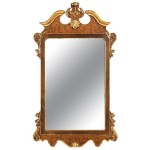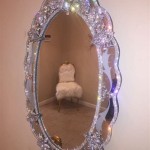Enhancing Your Dining Room with Mirrors: Ideas and Inspiration
Mirrors, beyond their functional purpose, serve as powerful design elements capable of transforming the ambiance and visual appeal of a dining room. Strategic placement and thoughtful selection of mirrors can amplify light, create the illusion of spaciousness, and add a touch of elegance to the dining experience. This article explores diverse dining room mirror ideas, providing insights into their application and impact on the overall aesthetic.
Maximizing Light and Space: Mirror Placement Fundamentals
One of the primary benefits of incorporating mirrors into a dining room is their ability to reflect and disperse natural and artificial light. This is particularly advantageous in rooms with limited natural light or smaller dimensions. The strategic positioning of mirrors can significantly enhance the brightness and feeling of openness.
Consider placing a large mirror on a wall opposite a window. This arrangement captures incoming sunlight and reflects it throughout the room, creating a brighter and more inviting atmosphere. The mirror acts as a supplementary light source, reducing the need for excessive artificial lighting during the day.
In dining rooms where space is a constraint, a well-placed mirror can visually expand the room's dimensions. A large mirror, spanning nearly the entire length of a wall, creates the illusion of a larger space by reflecting the room back onto itself. This technique is especially effective in narrow or rectangular dining rooms.
The height at which the mirror is mounted is also crucial. Mounting the mirror at eye level ensures that it reflects the most important elements of the room, such as the dining table setting and any decorative accents. Avoid placing the mirror too high, as this can create an awkward visual perspective.
Experiment with different mirror shapes and sizes to achieve the desired effect. A tall, narrow mirror can visually elongate the wall, while a wide, horizontal mirror can emphasize the room's width. The shape of the mirror should complement the overall style of the dining room.
Mirror Styles and Designs: Complementing Your Decor
The style and design of the mirror should align with the existing decor of the dining room. From ornate, antique-inspired mirrors to sleek, modern designs, the options are vast and cater to diverse aesthetic preferences. Selecting the right mirror style can enhance the room's overall cohesiveness and visual appeal.
For a traditional or formal dining room, consider a mirror with an elaborate frame. Gilded frames, intricate carvings, and antique finishes can add a touch of opulence and sophistication. These mirrors often serve as focal points, drawing attention to their intricate details and craftsmanship.
In a modern or minimalist dining room, opt for a mirror with a clean, simple design. Frameless mirrors or mirrors with thin, metallic frames are ideal for creating a sleek and contemporary aesthetic. These mirrors blend seamlessly into the background, allowing the room's other design elements to take center stage.
For a rustic or farmhouse-style dining room, consider a mirror with a wooden frame. Reclaimed wood, distressed finishes, and natural textures can add a touch of warmth and character. These mirrors often evoke a sense of history and authenticity, complementing the room's overall rustic charm.
Beyond traditional shapes, explore unconventional mirror designs to add a unique touch to the dining room. Geometric shapes, asymmetrical designs, and mosaic patterns can create a visually striking focal point. Consider incorporating mirrors with beveled edges or antique mirroring to add depth and character.
Consider incorporating multiple smaller mirrors instead of one large mirror. Grouping several smaller mirrors together can create a gallery wall effect, adding visual interest and depth to the space. This approach allows for greater flexibility in terms of placement and arrangement.
Beyond the Wall: Creative Mirror Applications
While wall-mounted mirrors are the most common application, there are numerous other creative ways to incorporate mirrors into the dining room. Exploring these alternative applications can add a unique and unexpected touch to the space.
Mirrored furniture, such as a mirrored buffet or sideboard, can add a touch of glamour and sophistication. The mirrored surfaces reflect light and create a sense of spaciousness, making the furniture appear lighter and less bulky. This application is particularly effective in smaller dining rooms.
Consider incorporating mirrored tiles as a part of a backsplash or accent wall. Mirrored tiles can add a subtle shimmer and reflect light, creating a visually interesting backdrop. This application is particularly suitable for modern or contemporary dining rooms.
A mirrored tray can serve as a stylish centerpiece on the dining table. The mirrored surface reflects the surrounding elements, such as candles, flowers, and tableware, creating a visually appealing and cohesive arrangement. This application is particularly effective for formal dinner parties.
Mirrored wall art can provide a unique and artistic touch to the dining room. These pieces often incorporate mirrored elements into abstract or geometric designs, adding depth and texture to the wall. This application allows for greater creativity and personalization.
Consider using a mirrored screen as a room divider. This can be particularly useful in open-concept living spaces where the dining area is not clearly defined. The mirrored screen creates a visual barrier while still allowing light to pass through, maintaining a sense of spaciousness.
Mirrored chandeliers or pendant lights can add a touch of glamour and create a stunning focal point. The mirrored surfaces reflect light and create a sparkling effect, enhancing the overall ambiance of the dining room. This application is particularly effective in formal or elegant settings.
Remember to consider the reflections created by the mirror. Ensure that the mirror reflects desirable elements, such as artwork, greenery, or a well-designed table setting. Avoid placing the mirror where it reflects clutter or unsightly views, as this can detract from the room's overall aesthetic.
Ultimately, the best dining room mirror ideas are those that reflect personal style and enhance the room's overall ambiance. By carefully considering the placement, style, and application of mirrors, it is possible to create a dining space that is both beautiful and functional.
Careful consideration should be given to the maintenance of dining room mirrors. Regular cleaning with a glass cleaner and soft cloth is essential to maintain their clarity and shine. Avoid using abrasive cleaners or harsh chemicals, as these can damage the mirror's surface. Consider using a lint-free cloth to avoid streaks and smudges.
In addition to cleaning, be mindful of the mirror's placement in relation to potential sources of damage. Avoid placing mirrors in areas where they are likely to be bumped or scratched. If the mirror is exposed to direct sunlight, consider using a UV-protective coating to prevent fading or discoloration. Regular inspections can help identify and address any potential issues before they escalate.

How To Decorate Your Home With Mirrors In Some Stunning Ways World Inside Pictures Mirror Dining Room Elegant Luxury

Transform Your Dining Room With A Mirror Decoholic
:strip_icc()/dining-room-mirror-ideas-1-ashley-montgomery-b90b98cab74443e9ab4f9d5e9f6ac2d2.jpeg?strip=all)
17 Dining Room Mirror Ideas That Ll Dress Up Your Walls

5 Dining Room Mirrors A Must Have For Every Home
/s3.amazonaws.com/static.havenly.com/assets/48adcbf2-e9ec-4fe8-b894-31ebc07283b7?strip=all)
Modern Dining Room Mirror Ideas Interior Design Havenly

55 Dining Room Wall Decor Ideas Interiorzine

The Best Dining Room Mirror Ideas Zhush
/s3.amazonaws.com/static.havenly.com/assets/3a000c5e-f112-445f-9f3f-086382f8396c?strip=all)
Traditional Dining Room Mirror Ideas Interior Design Havenly

Dining Room Mirror Ideas Glass Genius

Enhancing Interior Decor With Wall Mirrors Majestic Glass








